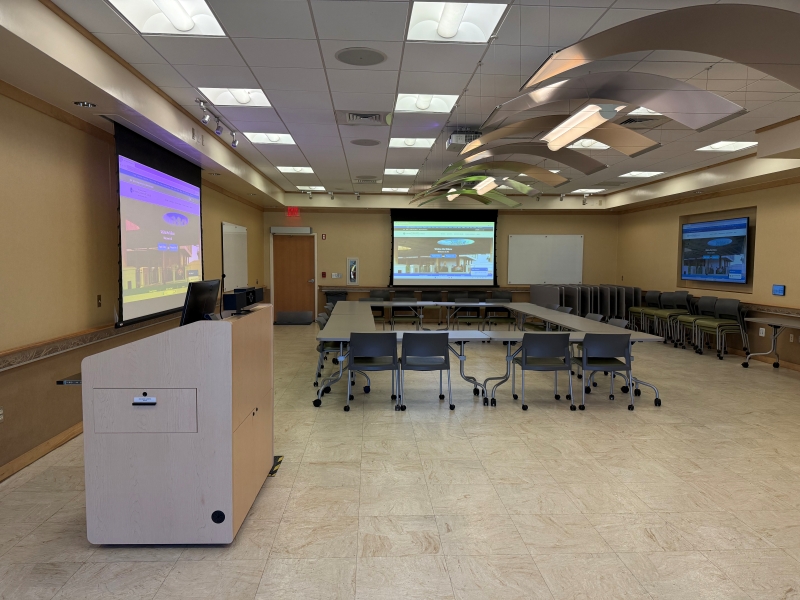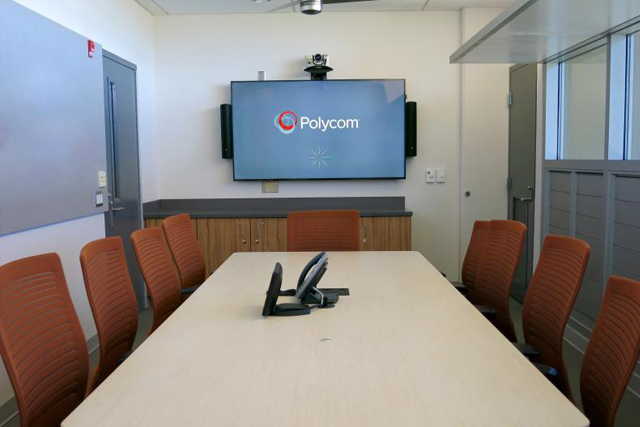Technology Enhanced Classroom (TEC)
“Technology Enhanced Classrooms” or TECs are the newest technology classrooms on campus featuring a modular design. A TEC includes standard equipment like a Smart Classroom but offers better equipment for an enhanced user experience. For instance, a laser projector that performs quieter and provides brighter images that can be used with the room lights on, an ADA-compliant podium with more table space, flat field speakers that more evenly distribute sound throughout the room, centralized video processing and switching controller to display different input devices, document camera, and the ability to add functionality in modules without affecting the overall operation of the room. (These add-ons are usually for a limited time and not part of the permanent TEC design.)
Hybrid Kit
One such temporary add-on module installed in TECs in Fall 2021 was a “hybrid kit” containing a document camera, graphics tablet, video capture card, video recorder and tripod, and lanyard mic to particularly support hybrid classes as well as socially-distanced in-person, hybrid, and DE modalities.
Keep your Student record updated
- Make sure you’re going to meet all of your degree requirements.
Keep your student record updated.
Hybrid Classroom Orientation
Learning in the 21st Century can be engaging and dynamic. Leeward CC has updated several of our campus classrooms with hybrid technologies to support active teaching and learning. Follow these three steps to get acquainted with the hybrid technology prior to class.
1. Pedagogy and Best Practices
(Full EMC post)
When planning for hybrid instruction you can leverage established best practices for online teaching and in-person facilitation. The following articles from Beth McMurtrie of The Chronicle of Higher Education entitle “Your Questions around Hybrid Teaching Answered”, serve as getting started point (Part 1, Part 2).
Main ideas and highlights:
- Invest in your course design, as if it were fully online class and think of the in-person part of it as an enhancement.
- Think of class time as a place to connect and regroup, as well as to review and experience in-person demonstrations.
- Minimize activities that have remote students passively watch you engage with in-person students.
- Pair remote students with in-person students in small group break out rooms.
- Infuse Active Learning (Active Learning in Hybrid Classrooms)
- Actively grow and maintain Cognitive, Social, and Teaching Presence aspects of the Community Of Inquiry framework.
- Consider reducing the amount of classroom discussion, elect to ask students to respond to your questions through live polling, in Zoom. Those polls can also foster back-channel conversations, which can enhance, or provide an alternative to, classroom conversation.
- Collaborative note taking, in which students take turns working in a shared online Google document to take notes on a class discussion.
- Consider Zoom Breakout Rooms for small group work (remember to assign students roles within their group, goals to accomplish and time limit.
- Create resources prior to your sessions starting. Example: Sharing a Google Doc with links to resources, Setup Zoom Polls, Google Doc for collaborative notetaking.
- Lastly consider using Alternative assessments including SAMR (view slide deck).
2. Resources and Documentation
You will find the following hardware integrated into the hybrid classrooms.
- Graphics Tablet by Wacom
A small, wired graphics tablet (6”x4”) with stylus. Can be used in replacement of using the mouse. This device can be used annotate content (such as when used with Zoom Whiteboard) and is also a replacement for white board in the physical classroom. - Document Camera by ELMO
A high resolution wired USB down facing camera which can capture entire sheets of paper books in one shot, great for displaying three dimensional items. - Capture Card by Elgato
An interface box that allows for connecting external HDMI video devices to the classroom computer in order to use with Zoom. Don’t forget to bring and HDMI cable for your device to connect. - Video Recorder by Zoom
Video recorder with standing tripod. Can be used instead of the built in web camera. Provides a wide angle shot. Built in microphone can pick up audio in entire room (i.e. instructor and students).
Quick Start User Guide(link is external)
Complete User Guide(link is external) - Orientation Resources
3. Make an Appointment for an Orientation
Contact the Educational Media Center to arrange a date and time to meet with you to orient you to the room.
Computers
TECs are equipped with all-in-one Dell computers with a pop-up webcam, running Windows 11 operating system.
Since new computers do not have CD/DVD drives, we encourage instructors to use streaming media. The Leeward Library can support you in this area.
Smart Classroom
“Smart Classrooms” were the first technology classroom on campus which included a lectern, computer, speakers, and either a large projector and screen or monitor. Since they were completed in phases, various “generations” of rooms resulted with different audio-visual (AV) equipment. Click on the links below to view a quick reference guide for each Smart Classroom generation. You may also view the Smart Classroom locations.
- Generation 1 – mixer/amplifier for sound (located inside the lectern)
- Generation 2 – speakers
- Generation 3 and 4 – lectern with AV controller, VGA input cable for laptop, ceiling speakers
- Generation 5 – lectern with AV controller with switcher, HDMI input cable for laptop, ceiling speakers
- Generation 6 (ED Bldg) – lectern with touch panel AV controller, SMART Board, HDMI input for laptop, Airplay, room microphone, ceiling speakers, and moveable chairs and tables
- Generation 7 – flat screen monitor, HDMI input cable for laptop
Beginning Fall 2021, the Smart Classroom will no longer be funded and installed, and will phase out by 2026. Instead, the new technology classroom will be the Technology Enhanced Classroom (TEC).
Multi-Purpose Rooms
thethe EMC’s AV Services unitThe campus has several types of rooms (i.e. classrooms, multi-purpose rooms, and conference rooms) with AV equipment.
Multi-purpose rooms are usually not scheduled for classroom instruction and oftentimes have enhanced technologies in the room. Click on the links below to view a room guide for each specialty room.
- Ka’ala Room (GT 105) – lectern with touch panel control, HDMI connector for laptop, room microphone, distributed speaker system, video bar, document camera, two projectors, and one monitor. This multifunctional room can be used for presentations, meetings, and active training sessions.
- Quick Guide to start up the room system (PDF)
- ED 201 (A&B) – lectern with touch panel control, VGA & HDMI connector for laptop, room microphone, distributed speaker system, projector, and two monitors. This multifunctional room can be used for presentations, meetings, and active training sessions.
- ED 301 – credenza with combination touch panel, button control, VGA & HDMI connector for laptop, AppleTV Airplay functionality, room microphones available on request, in-door speaker system linked to outdoor speaker system on roof-top lanai, controlled via wall panel, 55″ flat screen monitor. This multifunctional meeting room can be used for small presentations, group gatherings and events.
- Uluwehi Café – built-in ceiling mounted PA speakers to host presentations, awards or listening to local radio stations. Wireless microphones and a presentation podium are also available upon request. For assistance with sound system setup, please contact the EMC’s AV Services unit.
Video Conferencing
The campus has several rooms equipped with a video bar, providing a high-quality camera and speakerphone system that is integrated into the room’s AV system, allowing for web conferencing capabilities like Zoom and Google Meet. Since it’s already configured into the room’s AV system there is no additional setup. But if you would like further assistance, please contact the EMC’s AV Services unit. (Also, h.323 (Polycom) capabilities are available upon request through the EMC’s AV Services unit.)
To reserve a room, contact your Division’s Administrative Assistant.
Chancellor’s Conference Room (CCR) (AD 102)

Kaʻala Room (GT 105)

LC 108A

Contact Us
- ITG Help Desk for technical problems in the classrooms. Trouble calls will be routed to the appropriate unit, ITG Help Desk or AV Services.
- Instructional Designers for consultation on using the technologies in the classrooms for teaching.

